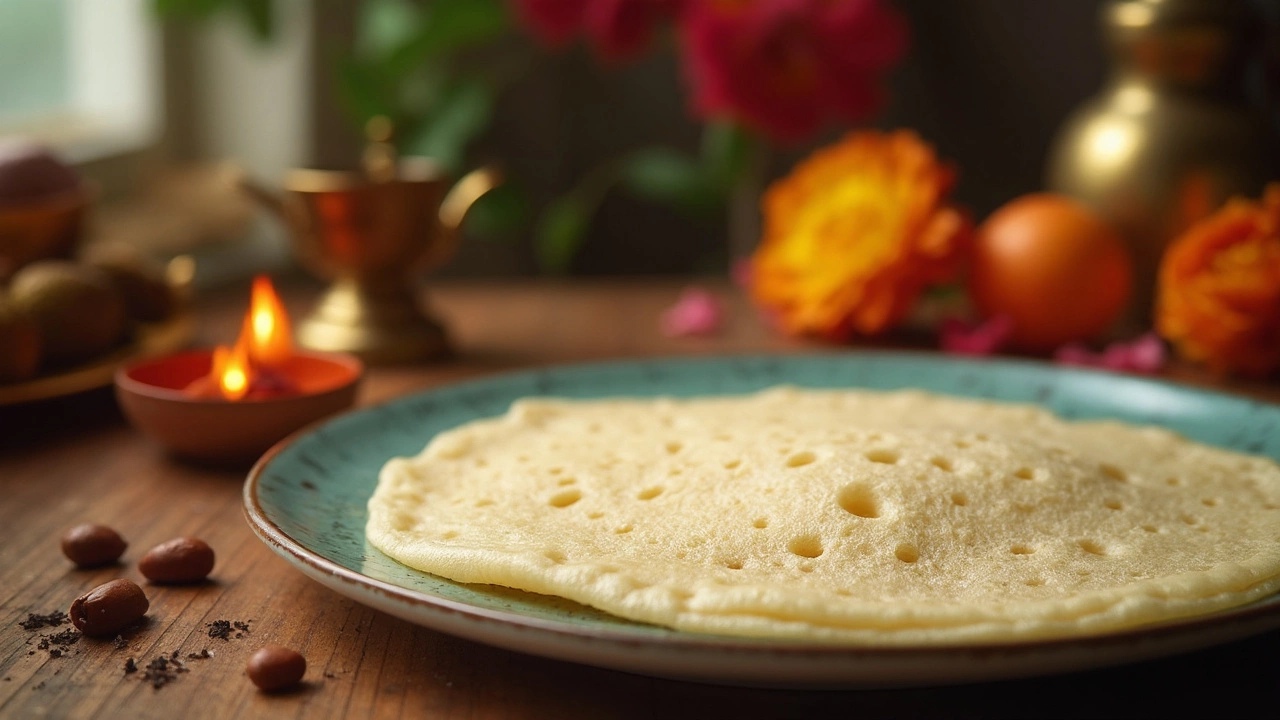Fast Track Your Dosa Batter Fermentation Without Yeast
 Feb, 13 2025
Feb, 13 2025
We all forget things sometimes, right? So, what if you forgot to leave your dosa batter to ferment? Don’t panic—you won’t need yeast to save the day! Speeding up dosa batter fermentation at home is entirely doable with a few nifty tricks.
First, warmth is what your batter craves. If your kitchen isn’t already warm, you can tuck the batter container in a nice little blanket or keep it near a low source of heat. A lit oven or your laptop running for hours can make surprising helpers!
Next up, think fermentation helpers. A little trick is adding a spoonful of cooked rice or a pinch of sugar. These foods can boost fermentation naturally, getting that batter bubbling away like there’s no tomorrow.
- Understanding Dosa Batter Basics
- Importance of Fermentation
- Using Warmth to Accelerate Fermentation
- Incorporating Natural Fermentation Boosters
- Monitoring and Storing for Future Batches
Understanding Dosa Batter Basics
If you've ever wondered what goes into making that perfect dosa, you've come to the right place. The foundation of a great dosa lies in its dosa batter. Let's break down what makes it tick.
Core Ingredients
The basic recipe for dosa batter includes rice and urad dal (black gram). The typical ratio is about 3:1, but that can change based on personal preference. This duo is soaked separately in water for a few hours before grinding together. You’ll want a smooth, slightly grainy texture for the mix.
Magic of Fermentation
Once ground, the batter needs to ferment. This process is what gives dosa its signature tang. During fermentation, naturally occurring bacteria in the dal thrive, breaking down starches and producing carbon dioxide. This is what makes the batter bubbly and light.
Consistency Matters
Can't stress this enough—consistency is king! Your batter should be neither too thick nor too thin. Aim for something like pouring cream. It might take a few tries to hit that sweet spot, but it’s worth it.
Pro Tip
Considering temperature is crucial. Tropical climates ferment batter effortlessly. If it’s cooler where you are, try using a warm spot in your home to help it along. Every little degree counts!
Here’s a nifty table to keep it all straight:
| Ingredient | Ratio |
|---|---|
| Rice | 3 Parts |
| Urad Dal | 1 Part |
Armed with these basics, your journey to making top-notch, yeast-free dosa begins at home.
Importance of Fermentation
Fermentation is practically the magic behind your beloved dosa batter fermentation. It’s what gives your dosa that irresistible tang, along with its light, fluffy texture. Without proper fermentation, you’d end up with a pancake-like flat tortilla instead of the thin, crispy delight that is dosa.
So, why is it important? For starters, this process naturally develops good bacteria, which in turn helps break down proteins and starches. This not only makes your dosas tastier but also easier to digest.
Boosting Flavor and Texture
The acid produced during fermentation is what gives dosas their signature sourness. This flavor profile is crucial and also helps give a sort of complex depth to your breakfast or dinner.
Then comes texture. Fermentation makes bubbles in the batter, which translates into lovely holes and a crispy surface when cooked. These little pockets of air not only give structure but also a delightful crunch that’s quite addictive.
Health Benefits Galore
Another reason why this process rocks is due to its health perks. Fermented foods are known to boast probiotics, which are great for your gut health. A healthier gut leads to better digestion and improved immunity. Who knew dosa could be part of your health regime?
In short, getting your fermentation right is a big deal. It’s key to transforming your homemade dosa from bland to bang on!

Using Warmth to Accelerate Fermentation
Alright, let’s talk about how warmth can be your secret weapon for speeding up dosa batter fermentation. Temperature plays a huge role here. The right warmth not only encourages those good bacteria to party but also does so without using any yeast!
Optimal Temperature Range
Ideally, your batter should be sitting in an environment around 30-35°C (86-95°F). This range is where the magic really happens. Too cold, and things slow down. Too hot, and you're risking spoiling the batter.
Where to Find Warmth
- Oven Trick: Preheat your oven to about 30°C and turn it off. Place the batter on a lower rack. It’s like a cozy sauna in there.
- Sunny Spot: If you have a sunny ledge or window, park your batter there. Natural sunlight can do wonders.
- Appliance Magic: Close to a running appliance like a fridge or laptop can be surprisingly effective.
Wrapping for Warmth
Simple yet effective—wrap your container in a thick towel or a blanket. This helps to trap heat, keeping the batter snug and ensuring consistent warmth throughout the process.
Want some numbers? A study showed that using a warm light source increased the fermentation rate by almost 30%. Imagine getting that crispy dosa lushness faster!
Remember, keeping track of the time is essential. Check after eight hours. If it’s still not there, give it a couple of more hours.
Incorporating Natural Fermentation Boosters
Alright, let’s talk about giving your dosa batter fermentation a natural nudge without reaching for that yeast. We’re talking about simple stuff you likely already have at home.
Add a Spoonful of Cooked Rice
One of the oldest tricks in the book is adding cooked rice. This small addition acts as a catalyst, encouraging the fermentation process. Just toss in a tablespoon or two into the batter, and you'll notice results in a matter of hours. The starches in the rice break down, speeding up the bacterial activity needed for proper fermentation.
Use a Bit of Sugar
If you want to see those bubbles sooner, sugar is your buddy. A pinch of sugar can work wonders because it serves as food for the natural bacteria in the homemade dosa mix. But don't go overboard; a little goes a long way.
Embrace the Chillies or Fenugreek Seeds
Sounds surprising, right? Tossing in a couple of green chillies or a few fenugreek seeds can jumpstart your fermentation. They contain beneficial bacteria that aid the process. Just remember to wash the chillies well and go easy with the seeds to avoid altering the batter's taste.
These tricks don't just save the day; they help you maintain the traditional flavors that make dosas so delicious. Skip the yeast and try these handy methods next time that batter needs a quick fix!

Monitoring and Storing for Future Batches
So, you’ve successfully sped up your dosa batter fermentation without yeast—nice job! But what about keeping track of it and ensuring the next batch is just as perfect? Keeping an eye on the fermentation process is key.
Firstly, watch the batter rise. Ideally, it should almost double in volume. If it looks like it’s climbing, but you’re unsure, do the smell test. A mild tangy aroma is what you want. If it smells too sour, you may have over-fermented it.
Storing Your Batter
Once you’ve nailed the fermentation, it’s all about proper storage. Pour the batter into an airtight container and pop it in the fridge. This can keep for up to a week! Notice the quantity, though. Leaving some space at the top is a good idea, just in case it continues to rise a bit more.
Planning for Next Time
Here’s a cool trick: options like storing a tablespoon of your fermented batter to kickstart your next batch, much like how sourdough starters work. It saves you time and guarantees that fabulous flavor. Just mix it in with your raw ingredients and let it do its thing! By keeping tabs on how much batter you use and adjusting for your family’s dosa cravings, you’ll soon find the sweet spot.
| Refrigeration Tips | Shelf Life |
|---|---|
| Airtight Container | 5-7 days |
| Covered Bowl | 3-5 days |
With this knowledge, you're not just making dosas; you’re perfecting a craft. Experimenting and upping your game with proper monitoring and storing tactics will have you crafting dosas like a pro, all while dodging the yeast!